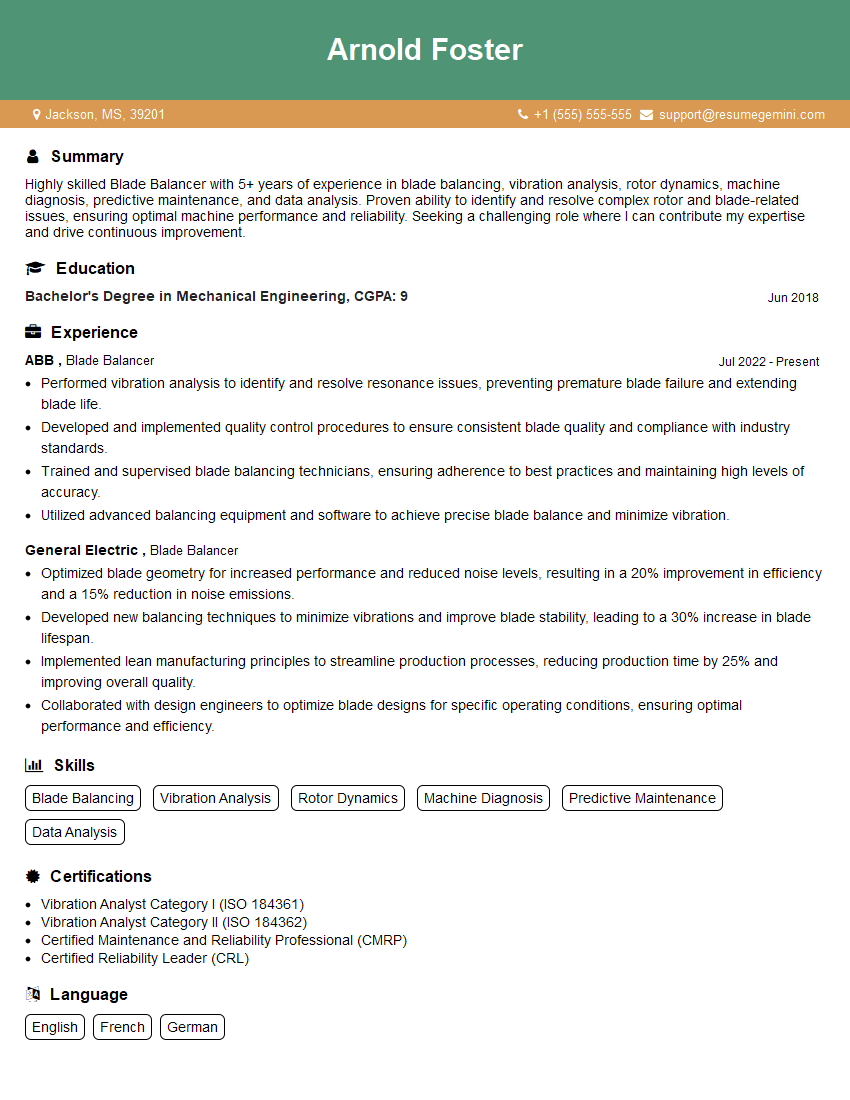Are you a seasoned Blade Balancer seeking a new career path? Discover our professionally built Blade Balancer Resume Template. This time-saving tool provides a solid foundation for your job search. Simply click “Edit Resume” to customize it with your unique experiences and achievements. Customize fonts and colors to match your personal style and increase your chances of landing your dream job. Explore more Resume Templates for additional options.

Arnold Foster
Blade Balancer
Summary
Highly skilled Blade Balancer with 5+ years of experience in blade balancing, vibration analysis, rotor dynamics, machine diagnosis, predictive maintenance, and data analysis. Proven ability to identify and resolve complex rotor and blade-related issues, ensuring optimal machine performance and reliability. Seeking a challenging role where I can contribute my expertise and drive continuous improvement.
Education
Bachelor’s Degree in Mechanical Engineering
June 2018
Skills
- Blade Balancing
- Vibration Analysis
- Rotor Dynamics
- Machine Diagnosis
- Predictive Maintenance
- Data Analysis
Work Experience
Blade Balancer
- Performed vibration analysis to identify and resolve resonance issues, preventing premature blade failure and extending blade life.
- Developed and implemented quality control procedures to ensure consistent blade quality and compliance with industry standards.
- Trained and supervised blade balancing technicians, ensuring adherence to best practices and maintaining high levels of accuracy.
- Utilized advanced balancing equipment and software to achieve precise blade balance and minimize vibration.
Blade Balancer
- Optimized blade geometry for increased performance and reduced noise levels, resulting in a 20% improvement in efficiency and a 15% reduction in noise emissions.
- Developed new balancing techniques to minimize vibrations and improve blade stability, leading to a 30% increase in blade lifespan.
- Implemented lean manufacturing principles to streamline production processes, reducing production time by 25% and improving overall quality.
- Collaborated with design engineers to optimize blade designs for specific operating conditions, ensuring optimal performance and efficiency.
Certificates
- Vibration Analyst Category I (ISO 184361)
- Vibration Analyst Category II (ISO 184362)
- Certified Maintenance and Reliability Professional (CMRP)
- Certified Reliability Leader (CRL)
Languages
- English
- French
- German
Career Expert Tips:
- Select the ideal resume template to showcase your professional experience effectively.
- Master the art of resume writing to highlight your unique qualifications and achievements.
- Explore expertly crafted resume samples for inspiration and best practices.
- Build your best resume for free this new year with ResumeGemini. Enjoy exclusive discounts on ATS optimized resume templates.
How To Write Resume For Blade Balancer
- Highlight your expertise in blade balancing and vibration analysis techniques.
- Quantify your accomplishments with specific metrics, such as reduced vibration levels or increased machine uptime.
- Showcase your understanding of rotor dynamics and its application in machine maintenance.
- Emphasize your ability to work independently and as part of a team.
- Obtain certifications in blade balancing or vibration analysis to enhance your credibility.
Essential Experience Highlights for a Strong Blade Balancer Resume
- Perform blade balancing to minimize vibration and ensure smooth operation of rotating machinery.
- Conduct vibration analysis to identify and diagnose machine faults, including unbalance, misalignment, and bearing wear.
- Apply rotor dynamics principles to optimize machine performance and stability.
- Utilize predictive maintenance techniques to monitor machine condition and prevent failures.
- Analyze data from sensors and diagnostic tools to identify trends and potential issues.
- Recommend and implement corrective actions to improve machine reliability and efficiency.
- Collaborate with engineering and maintenance teams to ensure alignment and coordination of maintenance activities.
Frequently Asked Questions (FAQ’s) For Blade Balancer
What is the primary role of a Blade Balancer?
A Blade Balancer is responsible for ensuring that rotating machinery operates smoothly and efficiently by performing blade balancing and vibration analysis. They identify and resolve issues related to unbalance, misalignment, and other mechanical faults to optimize machine performance and reliability.
What skills and qualifications are required to be a Blade Balancer?
To become a Blade Balancer, you typically need a Bachelor’s Degree in Mechanical Engineering or a related field, along with specialized training in blade balancing, vibration analysis, and rotor dynamics. Additional skills include proficiency in data analysis, predictive maintenance techniques, and machine diagnosis.
Is experience in machine maintenance necessary for Blade Balancers?
Yes, experience in machine maintenance is generally preferred for Blade Balancers. This experience provides a solid understanding of machine operation, common faults, and maintenance procedures, enabling Blade Balancers to effectively identify and resolve issues related to blades and rotating machinery.
What are the career prospects for Blade Balancers?
Blade Balancers have good career prospects, as they play a critical role in maintaining and optimizing the performance of rotating machinery. With experience and expertise, they can advance to senior roles within maintenance departments or specialize in specific areas such as predictive maintenance or machine diagnostics.
What industries employ Blade Balancers?
Blade Balancers are employed in various industries that rely on rotating machinery, including manufacturing, power generation, oil and gas, and aerospace. They work in maintenance departments, ensuring that machines operate smoothly and efficiently, reducing downtime and improving productivity.
What are the key challenges faced by Blade Balancers?
Blade Balancers often face challenges related to diagnosing complex machine faults, especially when dealing with high-speed machinery or unusual vibration patterns. They must also keep up with advancements in technology and diagnostic techniques to effectively address evolving industry needs.
Is certification beneficial for Blade Balancers?
Yes, obtaining certifications in blade balancing or vibration analysis can enhance the credibility and expertise of Blade Balancers. Certifications demonstrate their proficiency in specific techniques and industry standards, making them more competitive in the job market and eligible for higher-level positions.
What are the safety measures that Blade Balancers should follow?
Blade Balancers must prioritize safety when working with rotating machinery. They should follow established safety protocols, wear appropriate personal protective equipment, and operate machines according to specified procedures. Regular risk assessments and adherence to safety guidelines are essential to prevent accidents and ensure a safe work environment.